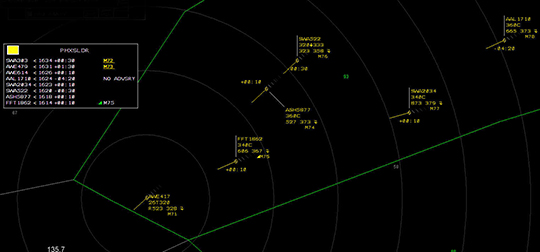Airspace Operations Lab ATD-1 Ground Based Interval Management-Spacing (GIM-S) Study
From April 20 to April 24 the Airspace Operations Lab at NASA Ames Research Center successfully completed a human-in-the-loop simulation study on Ground Based Interval Management-Spacing (GIM-S) for NASA's Air Traffic Management Demonstration -1 (ATD-1). The objective of the simulation was to evaluate the accuracy and efficiency of time-based metering operations using the FAA's Time-Based Flow Management System (TBFM) with different delay indications and speed advisories for the air traffic controllers operating in Center airspace. Two retired air traffic controller teams, mostly from Albuquerque Center (ZAB), each staffed seven air traffic control positions in ZAB, Denver Center (ZDV), Kansas City Center (ZKC) and Phoenix TRACON (P50). The teams controlled arrivals entering Phoenix TRACON from the north from approximately 500 nautical miles away, along with some crossing traffic. The TBFM (4.2.3) system provided the Center controllers with scheduling and time-based metering information, and also provided Terminal and Sequencing and Spacing (TSS) information to the TRACON controllers. The study was designed with a 2x2 test matrix that varied the delay-display accuracy between tens of seconds and rounded minutes, as well as the availability of GIM-S speed advisories to the Center controllers. Initial observations and feedback during the debriefing indicate that controllers were able to deliver aircraft with sufficient accuracy to the TRACON in all conditions. The tens-of-seconds delay indication appeared more accurate to the TRACON controllers. The GIM-S speed advisories were generally considered useful by the controllers working aircraft during cruise flight and not as useful in the sector managing the descent portion of the arrival traffic. A detailed analysis of delivery accuracy, flight efficiency, safety, controller workload, and acceptability will be conducted. This research will further support the operational integration of the TSS ground tools that ATD-1 successfully transitioned from NASA to the FAA.

Air traffic controller monitoring aircraft during cruise flight for a human-in-the-loop simulation study on Ground Based Interval Management-Spacing (GIM-S) for NASA's Air Traffic Management Demonstration -1 (ATD-1)

Air traffic control display showing new and issued Ground Based Interval Management-Spacing (GIM-S) advisories
Point of Contact: Tom Prevot (ARC-TH), Thomas.Prevot@nasa.gov, (650) 604-2441 |